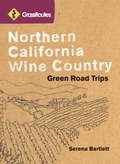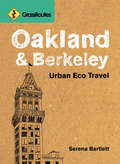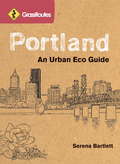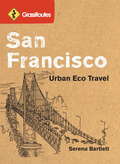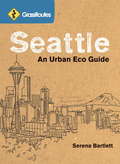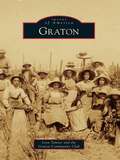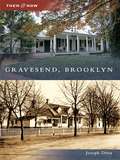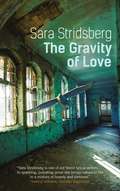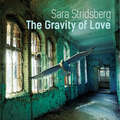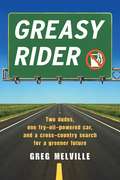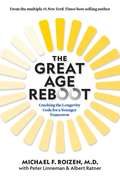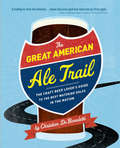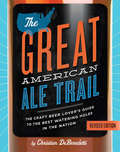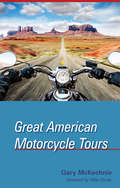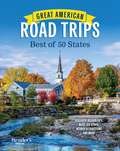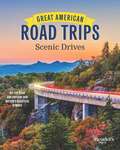- Table View
- List View
Grassroots Baseball: Where Legends Begin
by Jean FruthIn Grassroots Baseball: Where Legends Begin, photographer Jean Fruth features more than 250 of the best images from all levels of the amateur game in various US cities, as well as several hotbeds of baseball around the world. Each chapter opens with a portrait of a baseball legend and a first-person essay recounting his early memories of playing the game. Some of the stars highlighted in this full-color book include Whitey Ford, Vladimir Guerrero, Hank Aaron, Randy Johnson, Nolan Ryan, and Ichiro Suzuki. The pages that follow in each chapter document the game from sandlots to big-time ballparks, and at every level of organized baseball, giving readers a window into how these legends' careers began. With an introduction by Cal Ripken, Jr., a foreword by Steve Wulf, and an afterword by Johnny Bench, this book makes the perfect gift for baseball fans of all teams.
Grassroots Baseball: Route 66
by Jean Fruth Jeff Idelson Jim ThomeJust as baseball is at the heart of America, so too is Route 66. This book is a photographic tribute to the national pastime along the artery that stretches from the shores of Lake Michigan, close to where the Cubs play, to the Pacific Ocean at Santa Monica, where baseball memories and players abound. Among the players who will guide readers on the journey will be baseball greats George Brett, Billy Hatcher, Alex Bregman, and Ryan Howard. Leading off will be Johnny Bench of Binger, Oklahoma, and cleaning up will be Jim Thome of Peoria, Illinois.In Grassroots Baseball: Route 66, photographer Jean Fruth weaves more than 250 full-color images of the national pastime along the historic highway into a tapestry that reminds us of the heart and soul of America.Route 66 passes through eight states in its journey to the Pacific, and each chapter opens with a first-person essay by a baseball legend from that locale recounting his early memories of playing the game, and what it was like growing up along the Mother Road. That highway took stars like George Brett, Billy Hatcher, Alex Bregman, Adam LaRoche, and Ryan Howard to faraway places they only dreamed about as kids.Each chapter documents the route they took, from sandlots, ranches, and beaches to ballparks at every level of organized baseball, from Little League games to the World Series. With an introduction by Johnny Bench, a foreword by Mike Veeck, a preface by retired Hall of Fame President Jeff Idelson, and an afterword by Jim Thome, this book touches all the bases for any and every baseball fan.
GrassRoutes Northern California Wine Country
by Serena BartlettGrassRoutes Travel aims to show you a whole new way to explore and enjoy Northern California Wine Country. Divided up into 5 distinct regions: Undiscovered Coast (From Pt. Reyes Station to Westport along the coast), Cow Country (Cloverdale to Guerneville and environs), Santa Sonoma (Santa Rosa, Sonoma and Petaluma), New Napa (Yountville to American Canyon including Suisun Valley), Suburban Cowboys (Livermore and Pleasanton to Niles). The book is organized around and between these regions with access info for driving (w/ biodiesel fuel sources, of course), biking, and public transportation. Each region is then given the usual GrassRoutes treatment with pointers to the most interesting and inspiring local shops, activities, grub, scenes, etc. The travel guidebook category has gotten into a rut with cookie-cutter series galore. GrassRoutes guides do not recycle the same old tired info. The foundation of each guide is the actual experience of the writers--starting with series founder Serena Bartlett. What other guide to a city offers up an annotated listing of places to volunteer, encourages you to take the bus, and directs you to places to find inspiration
GrassRoutes Oakland and Berkeley, Second Edition
by Serena BartlettSerena Bartlett started the GrassRoutes Travel series with Oakland because it was a mystery why a vibrant energized city like that didn't have a decent guidebook to call its own. So, to point residents, travelers, and sojourners to the best cafes, markets, music, art, contemplative places, and friendly scenes, here is the New View of the City Next Door. Turns out there is a there there, and totally cool. Whether it's vegan organic or late-night literary, an urban bike tour or stalking fine art and architecture, this guide points the way. GrassRoutes Travel describes a new eco-urban adventure that reveals the lively metropolis always in the shadow of San Francisco. The travel guidebook category has gotten into a rut with cookie-cutter series galore. GrassRoutes guides do not recycle the same old tired info. The foundation of each guide is the actual experience of the writers--starting with series founder Serena Bartlett. What other guide to a city offers up an annotated listing of places to volunteer, encourages you to take the bus, and directs you to places to find inspiration?
GrassRoutes Portland
by Serena BartlettDelve deeper into Portland with the latest guide in the GrassRoutes series. Reflecting the new interest in sustainable living, localtarian experiences, and indie/alternative locations, GrassRoutes Portland features authentic reviews by people who practice what they preach. Taste a Vietnamese-French sandwich, or meet some locals by helping weed gardens in a public P-patch. Have a splurge dinner made by a chef who grows her own greens, and then stay up late at a poetry reading. The guide points travelers and locals alike to an urban eco-adventure that reveals a new look at Portland - a city chock-full of bustling, eccentric neighborhoods. The foundation of each GrassRoutes guide is the actual experiences of local writers who encourage visitors and residents to take the bus, volunteer, and find inspiration.
GrassRoutes San Francisco, Second Edition
by Serena BartlettGrassRoutes travel guides cover a variety of local scenes at their best: from getting around sans car to getting creatively inspired, from the hottest music venues to the quietest places to open a book. GrassRoutes San Francisco offers a wealth of ways for small-footprint visitors to deepen their experience of one of America's most exciting cities. Written by locals immersed in the eco/indie/alt scene, the book covers everything from carpooling and volunteering, to potluck dinners and fair trade cafes, to attending community events and buying CDs from local musicians. Categories include Up Early, Hang Out, Pamper, Listen, Get Inspired, Stay Up Late, and many more. Black-and-white illustrations show the city highlights, while clear maps help visitors get around easily on foot, bike, and public transportation.
GrassRoutes Seattle
by Serena BartlettGrassRoutes Seattle points visitors to a new urban eco adventure, allowing them to explore Seattle beyond just a visit to the Space Needle. Emphasizing humble over haute, this new guide takes travelers deep into the local scene at its best: from indie shops to late-night eateries; from walking, biking, and hiking to finding creative inspiration; from finding cheap music venues and thrift shops to locating freebies and activist hang-outs. Clear maps and black-and-white illustrations keep readers oriented. Based on the writers' actual experiences and familiarity with the scene, this timely guide lets travelers make their trips to the Emerald City creative, fun, and meaningful.
Graton
by Lesa Tanner Graton Community ClubThe town of Graton is located in the beautiful and fertile Green Valley, which was first settled in the mid-1800s by pioneer families such as the Sullivans, Gregsons, and Winklers. When the railroad came through the area, realtor James Gray and banker J. H. Brush bought land and created one of the first subdivisions in Sonoma County. They named the streets after themselves and their children, and in 1905, Graton was born. Along with the agricultural industry in California, the town thrived until the 1970s and then declined, only to be reborn in the 1990s. Throughout all Graton's phases, Oak Grove School (1854), the Pacific Christian Academy (1918), and the Graton Community Club (1914) remained vital. Graton is now part of a premiere wine-growing region, and visitors as well as locals are attracted to its vibrant downtown businesses, award-winning restaurants, and artistic community.
Gravel Cycling: The Complete Guide to Gravel Racing and Adventure Bikepacking
by Nick LeganHead out for adventure on the unpaved back roads of America with Nick Legan&’s complete guide to gravel grinders and bikepacking! Gravel cycling is a glorious return to the purest roots of two-wheeled adventure. From farm roads and miners&’ paths to the high passes of the Rockies and the Alps, gravel cycling and bikepacking will set you free to explore, enjoy, persevere, and discover. Escape the traffic and ride unpaved with Nick Legan&’s GRAVEL CYCLING: The Complete Guide to Gravel Racing and Adventure Bikepacking. In this ground-breaking guide, accomplished gravel cyclist Nick Legan shares everything you need to know to enjoy gravel cycling and bikepacking. Drawing on interviews with top gravel junkies and his own hard-won knowledge from countless backcountry miles, Legan covers all the gear, bike setup, riding tips, course previews, and outfitting strategies you need to enjoy gravel cycling with confidence. He profiles 18 favorite one-day gravel races and 8 epic multi-day bikepacking adventure routes. Legan shares colorful stories of the origins of gravel cycling in North America and its rapid spread to Europe, Asia, and South America. Best of all, this full-color guide is packed with more than 350 gorgeous photographs from beautiful rides that will inspire you to seek out dirt and gravel roads near you. Legan brings his experience as a ProTour bike mechanic to this guide, offering detailed data on bike setup, gear selection, and how to build your own dream gravel bike. He shares crucial ride-saving tips and smart ways to make sure you&’ll enjoy every moment. Over one-third of the roads in the U.S. are unpaved, which means you can enjoy the roads less travelled at the perfect pace to soak up new vistas and valleys, canyons and creeks—or push the pace over an epic day with fast friends. From gear to racing, route planning to camping—the wild ride of a lifetime awaits you in GRAVEL CYCLING. Gravel grinders Includes complete profiles, tips, and gear set-up for favorite gravel races and events: Almanzo, Barry-Roubaix, Crusher in the Tushar, Deerfield Dirt Road Randonnée, Dirty Kanza, Dirty Reiver, Grasshopper, Gravel Fondo, Gravel Roc, Gravel Worlds, Great Otway, Grinduro, La Gravel66, La Résistance, Land Run, Pirinexus 360, Rebecca&’s Private Idaho, Trans Iowa. Bikepacking Offers route guides to favorite multi-day bikepacking routes: The Arizona Trail, The Colorado Trail, Denali Highway, Great Allegheny Passage and C&O Towpath, Great Divide Mountain Bike Route, Katy Trail, Oregon Outback, and Trans North California.
Gravesend, Brooklyn (Then and Now)
by Joseph DittaPermanently settled in 1645, the farming town of Gravesend, Long Island, was annexed to the city (now borough) of Brooklyn, New York, in 1894. Few reminders from Gravesend's rural days survive around the urban landscape it has become. Even its more recent past is quickly disappearing.
The Gravity of Love
by Sara StridsbergA dazzlingly inventive and acclaimed novel set in a Stockholm psychiatric hospital - by one of Sweden's most exciting literary talents"I'll put my head in the oven so you know where I am," he whispers, kissing her neck.Jim - charming, captivating, much loved by his women friends - has attempted suicide several times. Over his period of incarceration at the Beckomberga hospital for the mentally unstable, he voices his determination to succeed. Some day soon, he tells his daughter - as he has earlier told his mother and his wife - he will swallow sixty tablets, help them down with a bottle of whisky, and swim impossibly far out into the Atlantic.Will he, really? This question plagues Jim's daughter, the narrator of this powerful novel, who is as addicted to the hospital as her father is to alcohol. Through her subtle observations we understand the emotional needs of diehard alcoholics, the rationally uxoricidal, and other seemingly normal inhabitants of a psychiatric unit in the process of shutting down, depriving them of the only place they have known as home.A Magic Mountain for our times, for readers of Eimear McBride and Alexander Masters.Translated from the Swedish by Deborah Bragan-Turner
The Gravity of Love
by Sara StridsbergA dazzlingly inventive and acclaimed novel set in a Stockholm psychiatric hospital - by one of Sweden's most exciting literary talents"I'll put my head in the oven so you know where I am," he whispers, kissing her neck.Jim - charming, captivating, much loved by his women friends - has attempted suicide several times. Over his period of incarceration at the Beckomberga hospital for the mentally unstable, he voices his determination to succeed. Some day soon, he tells his daughter - as he has earlier told his mother and his wife - he will swallow sixty tablets, help them down with a bottle of whisky, and swim impossibly far out into the Atlantic.Will he, really? This question plagues Jim's daughter, the narrator of this powerful novel, who is as addicted to the hospital as her father is to alcohol. Through her subtle observations we understand the emotional needs of diehard alcoholics, the rationally uxoricidal, and other seemingly normal inhabitants of a psychiatric unit in the process of shutting down, depriving them of the only place they have known as home.A Magic Mountain for our times, for listeners of Eimear McBride and Alexander Masters.Translation (c)2016 Deborah Bragan-Turner (P)2016 WF Howes Ltd
Greasy Rider: Two Dudes, One Fry-Oil-Powered Car, and a Cross-Country Search for a Greener Future
by Greg MelvilleTwo intrepid trekkers take on the last great driving challenge and join our nation's fight against petroleum addiction. Is it possible to drive coast-to-coast without stopping at a single gas pump? Journalist Greg Melville is determined to try. With his college buddy Iggy riding shotgun, this green-thinking guy--who's in love with the idea of free fuel--sets out on an enlightening road trip. The quest: to be the first people to drive cross-country in a french-fry car. Will they make it from Vermont to California in a beat-up 1985 Mercedes diesel station wagon powered on vegetable oil collected from restaurant grease dumpsters along the way? More important, can two guys survive 192 consecutive hours together? Their expedition on and off the road includes visits to the solar-powered Google headquarters; the National Ethanol Council; the wind turbines of southwestern Minnesota; the National Renewable Energy Lab; a visit to one of the first houses to receive platinum certification for Leadership in Energy and Environmental Design (LEED); an "eco-friendly" Wal-Mart; and the world's largest geothermal heating system. Part adventure and part investigation of what we're doing (or not doing) to preserve the planet, "Greasy Rider" is upbeat, funny, and full of surprising information about sustainable measures that are within our reach.
The Great Age Reboot
by Michael F. RoizenAs the human lifespan expands and more people are living to 100 years and beyond, New York Times best-selling author Michael Roizen, M.D., explains how to prepare for a longer, healthier future. Over the next decade, people living to 100, 120, or even 130 years old will become increasingly common--and life past 100 may not look like what you expect. In this groundbreaking narrative, best-selling author Michael Roizen reveals how current science and technology will revolutionize our ability to live longer, younger, and better. Today's breakthroughs in longevity research are unprecedented, and this book will help you navigate the coming changes to make the best decisions for your brain, your body, and your bank account. Along with acclaimed economists Peter Linneman and Albert Ratner, Roizen explores how longer life spans will change our lives and our culture, providing the most comprehensive and forward-looking book on aging to date, and showing readers how to prepare for the next major societal disruptor. At long last, here is a road map to prevention, treatment, and technology that will reshape how we think about old age--and help us plan for an audacious future.
The Great American Ale Trail
by Christian DebenedettiThe Great American Ale Trail is the definitive guide to the best places to drink craft beer in America. Author Christian DeBenedetti has traveled across the country to find the worthiest beer destinations, from major breweries to tiny farmhouse startups. With hundreds of entries, including top-ten lists for "Best Dive Bars for Craft Beer Lovers", "Best Beer Festivals", and "Best Beer Cities", The Great American Ale Trail is sure to set anyone on their first beer pilgrimage.
The Great American Ale Trail
by Christian DebenedettiThe Great American Ale Trail is the definitive guide to the best places to drink craft beer in America. Author Christian DeBenedetti has traveled across the country to find the worthiest beer destinations, from major breweries to tiny farmhouse startups.With hundreds of entries, including top-ten lists for "Best Dive Bars for Craft Beer Lovers", "Best Beer Festivals", and "Best Beer Cities", The Great American Ale Trail is sure to set anyone on their first beer pilgrimage.
The Great American Ale Trail
by Christian DebenedettiThe Great American Ale Trail is the definitive guide to the best places to drink craft beer in America. Author Christian DeBenedetti has traveled across the country to find the worthiest beer destinations, from major breweries to tiny farmhouse startups.With hundreds of entries, including top-ten lists for "Best Dive Bars for Craft Beer Lovers", "Best Beer Festivals", and "Best Beer Cities", The Great American Ale Trail is sure to set anyone on their first beer pilgrimage.
The Great American Ale Trail (Revised Edition): The Craft Beer Lover's Guide to the Best Watering Holes in the Nation
by Christian DebenedettiSince its publication in 2011, The Great American Ale Trail has been the essential guide for thirsty travelers, featuring the worthiest places to enjoy great craft beers, from major breweries to farmhouse startups. Craft beer's popularity has grown and evolved tremendously in the past 5 years, so The Great American Ale Trail is back in a new, expanded edition to keep up with the scene. Beer expert and journalist Christian DeBenedetti has traveled the country and pinpointed more than 350 establishments that offer unforgettable beers. Whether you choose a mom-and-pop brewery or a gastropub with a quirky ambience, whether you prefer a hop-heavy stout or a smooth lager, The Great American Ale Trail is your ticket to finding memorable places with quality craft beer. Every entry features the must-try beer of the establishment, along with the address so go ahead and embark on your beer pilgrimage today!
Great American Motorcycle Tours
by Gary MckechnieYou're a rider. . . an independent spirit who's reluctant to follow someonelse's road map. But there are millions of miles of road to travel, and youould spend months searching for the best ones. Don't waste your valuablewo-wheeled vacation on ordinary routes. Instead, let Gary McKechnie be youruide. He's spent years exploring the nation by bike, and he gives you hisop 20 rides, from the rocky New England coast to the wide-open West. In thisetailed update of his best-selling guide, McKechnie includes: tips on siderips, scenic stops, and watering holes; advice on packing, equipment, roadonditions, rider-friendly attractions, and lists of conveniently-locatedotorcycle shops along the routes; and, on-the-road photographs andand-drawn maps.
Great American Railroad Journeys
by Michael Portillo<p>Great American Railroad Journeys sees the famous brand of social-history-cum-travelogue venture to the New World. Across multiple programmes and using Appleton's General Guide To The United States & Canada as reference, Michael Portillo now undertakes an epic trip by train from New York and Boston on the East Coast down to the Deep South of Atlanta and New Orleans, then on to Chicago, Colorado, New Mexico and ultimately finishing in San Francisco. This lavishly illustrated official tie-in covers each journey Portillo makes across North America and captures the colour, beauty, history and exhilaration experienced when journeying through this incredible continent. <p>Packed with new maps, as well as originals from Appleton's General Guide, this book explores the construction of rail routes across the continent in the 1800s, as a new nation was built by the immigrant masses. Truly this is a colourful and exciting enterprise, with vignettes of revealing social history displaying the rich tapestry of the peoples who established themselves in this vast new world. Great American Railroad Journeys is a must-have purchase for any fan of this unique and award-winning travel series.</p>
Great American Road Trips: Best of 50 States (RD Great American Road Trips #4)
by Reader'S DigestFuel your wanderlust with America&’s best travel destinations and get inspired to explore the natural beauty and rich history of all 50 states.The title says it all: Get the top road trip vacations the United States has to offer, all in one book. From small-town pit stops and off-the-beaten-path adventures to renowned historical sites and breathtaking parks, the destinations highlighted in this volume emphasize the unique beauty and history that each state has to offer. Whether you are a nature lover, history buff, or veteran road warrior, the incredible photography in this volume, along with the included recommendations for nearby attractions, lodging, recreation, and more, will inspire you to get packing. Jump in the car or RV and share these experiences with the ones you love! WEST Road Trips from Anchorage, Alaska Pacific Coast Highway, California Peak-to-Peak Scenic Byway, Colorado Volcanoes National Park, Hawaii City of Rocks, Idaho Glacier National Park, Montana Lamoille Canyon, Nevada John Day Fossil Beds, Oregon Scenic Byway 12, Utah San Juan Islands, Washington Yellowstone, Wyoming SOUTHWEST Catalina Highway, Arizona Mesilla, New Mexico Elk City, Oklahoma Piney Woods, Texas MIDWEST Shawnee National Forest, Illinois Nashville, Indiana Northeast Region, Iowa Elk Falls, Kansas Tunnel of Trees, Michigan Caledonia, Minnesota Hannibal, Missouri Sandhills, Nebraska Casselton, North Dakota Ashtabula County, Ohio Black Hills, South Dakota Amish Country, Wisconsin SOUTHEAST Appalachian Highlands, Alabama MONAH, Arkansas Sanibel and Beyond, Florida Savannah, Georgia Horse Country, Kentucky Cane River, Louisiana Chesapeake & Ohio Canal, Delaware Neshoba County Fair, Mississippi Flat Rock, North Carolina Hunting Island, South Carolina Cocke County, Tennessee Chincoteague, Virginia New River Gorge, West Virginia NORTHEAST Mystic Country, Connecticut Bayshore Byway, Delaware Highlands, Maine Quabbin Reservoir, Massachusetts White Mountains, New Hampshire Millbrook Village, New Jersey Finger Lakes, New York Gettysburg, Pennsylvania Trustom Pond Wildlife Refuge, Rhode Island Mad River Valley, Vermont NATIONAL PARKS Kenai Fjords National Park, Alaska* Lake Clark National Park, Alaska* Denali National Park, Alaska* Hawaii Volcanoes National Park, Hawaii Glacier National Park, Montana Yellowstone National Park, Wyoming Everglades National Park, Florida* Great Smoky Mountains National Park, Tennessee* New River Gorge National Park and Preserve, West Virginia *mentioned within a wider story
Great American Road Trips - Scenic Drives: Hit the Road and Explore Our Nation's Beautiful Scenic Byways
by Country MagazineLet the natural beauty of America&’s most scenic drives inspire the travel bug within you and get you exploring the wide-open spaces and breathtaking vistas in our country.Absorb the best America has to offer from the slow lane! This collection of scenic drives, broken out by region, features breathtaking road trips, both long and short. Highlighted by over 140 gorgeous photos, each trip also includes helpful info to help you plan your trip. Inspirational photos showcase why these well known drives are worth the drive. Many of the drives are described in the first person by people who have made the trip, taken the photos and visited the cool places along the way.
The Great American Staycation
by Matt WixonLayoffs are rampant, gas prices are volatile, airlines are cutting flights, and Americans are feeling the economic pinch of a recession. As much as we hate it in this country of big dreams, big cars and Big Macs, we have to find a way to cut back. For many Americans, that means turning the Great American Vacation into a "staycation," which is the big buzzword of the year, having appeared in articles everywhere from www.CNN.com to Newsweek. But what does a staycation really mean? Newspaper humor columnist and frequent staycationer Matt Wixon shares with readers the definition of a staycation as well as:Rules for a successful, satisfying vacation at home or nearbyMotivation and encouragement for people who can't afford the big, traditional vacationWays to make the most of time off from workStrategies and experiences from more than a dozen staycationers, as well as hundreds of Internet links and specific ideas to help plan a vacation in your hometown.From alternatives to destination theme parks to making the most of out local amenities to reigniting the flame in a relationship, Americans will find this guide a humorous and invaluable guide to staying home on vacation.
The Great American Staycation: How to Make a Vacation at Home Fun for the Whole Family (and Your Wallet!)
by Matt WixonLayoffs are rampant, gas prices are volatile, airlines are cutting flights, and Americans are feeling the economic pinch of a recession. As much as we hate it in this country of big dreams, big cars and Big Macs, we have to find a way to cut back. For many Americans, that means turning the Great American Vacation into a “staycation,” which is the big buzzword of the year, having appeared in articles everywhere from www.CNN.com to Newsweek. But what does a staycation really mean? Newspaper humor columnist and frequent staycationer Matt Wixon shares with readers the definition of a staycation as well as:Rules for a successful, satisfying vacation at home or nearbyMotivation and encouragement for people who can’t afford the big, traditional vacationWays to make the most of time off from workStrategies and experiences from more than a dozen staycationers, as well as hundreds of Internet links and specific ideas to help plan a vacation in your hometown.From alternatives to destination theme parks to making the most of out local amenities to reigniting the flame in a relationship, Americans will find this guide a humorous and invaluable guide to staying home on vacation.
The Great American Staycation
by Matt WixonLayoffs are rampant, gas prices are volatile, airlines are cutting flights, and Americans are feeling the economic pinch of a recession. As much as we hate it in this country of big dreams, big cars and Big Macs, we have to find a way to cut back. For many Americans, that means turning the Great American Vacation into a ?staycation,? which is the big buzzword of the year, having appeared in articles everywhere from www. CNN. com to Newsweek. But what does a staycation really mean? Newspaper humor columnist and frequent staycationer Matt Wixon shares with readers the definition of a staycation as well as: Rules for a successful, satisfying vacation at home or nearby Motivation and encouragement for people who can't afford the big, traditional vacation Ways to make the most of time off from work Strategies and experiences from more than a dozen staycationers, as well as hundreds of Internet links and specific ideas to help plan a vacation in your hometown. From alternatives to destination theme parks to making the most of out local amenities to reigniting the flame in a relationship, Americans will find this guide a humorous and invaluable guide to staying home on vacation.


